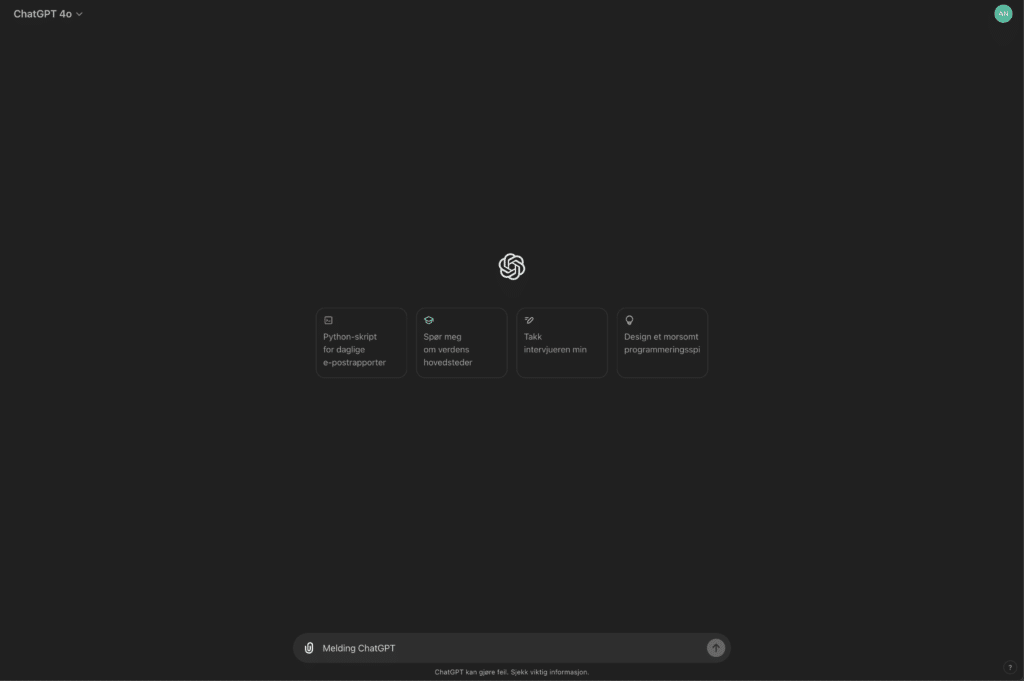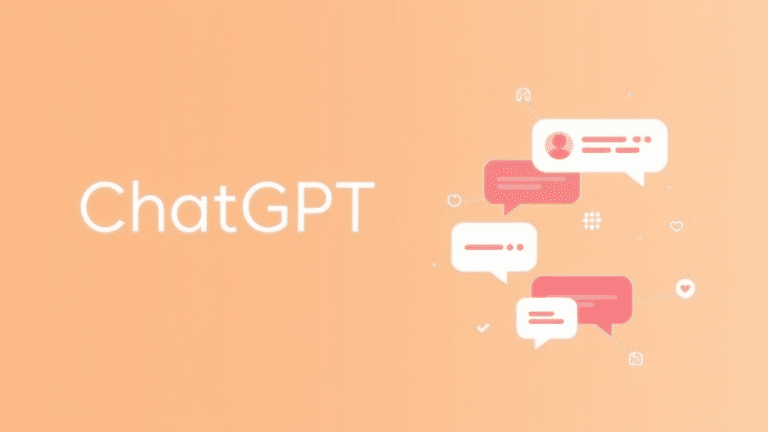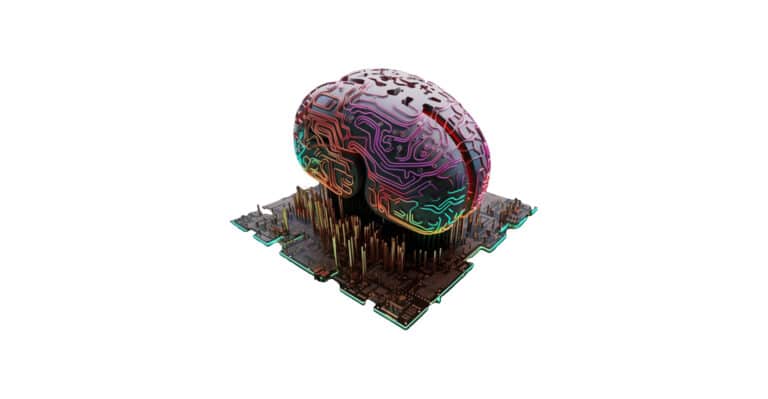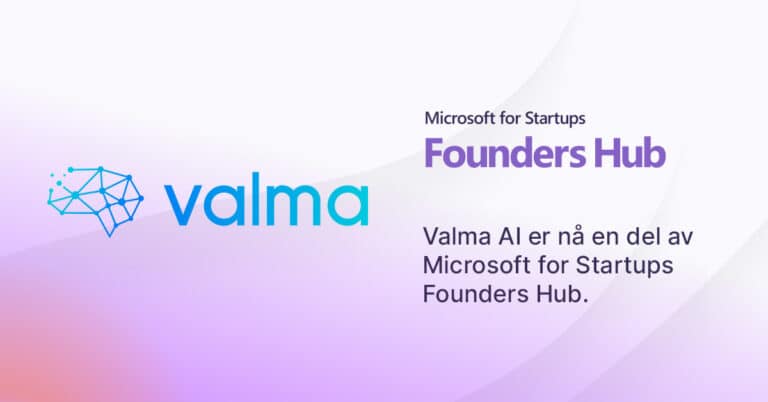You've probably heard about ChatGPT from news, friends or colleagues, but what exactly is ChatGPT?
In short, ChatGPT is an advanced chatbot powered by artificial intelligence (AI – from English Artificial Intelligence).
Think of it as a super-smart conversation partner that can answer questions, give advice, and even keep you company.
ChatGPT is designed to understand and generate human language in a way that is both natural and engaging. It's like having a conversation with a friend – a friend who happens to know an awful lot about almost everything!
How does ChatGPT work?
So, how does this AI make the magic happen? ChatGPT works using something called a "neural network." Without getting too technical, we can say that it is a type of machine learning that is inspired by how our brain works.
ChatGPT is trained on huge amounts of text data from the internet. This means it has read everything from Wikipedia articles to social media discussions. When you ask a question, it analyzes all this data to give you the most relevant and coherent answer.
Who made ChatGPT and why is it popular?
ChatGPT was developed by OpenAI, a research organization that aims to ensure that artificial intelligence benefits all of humanity. OpenAI has brought together some of the sharpest minds in technology and research to create this AI. But why has ChatGPT become so popular? Well, there are several reasons for that.
First, its ability to understand and generate natural language makes it incredibly useful for a variety of applications – from customer service to personal assistance. People love ChatGPT because it almost feels like talking to a real person.
Second, the availability of technology has also helped. OpenAI has made it easy for developers and companies to integrate ChatGPT into their own systems, which has led to a wide spread of its use.
So, whether you need help with homework, want to write an email, or just want a conversation partner, ChatGPT is here to make life a little easier and a lot more interesting.
Use of ChatGPT

When it comes to using ChatGPT, it is important to understand how to maximize the benefits of this AI assistant. Whether you are a beginner or an experienced user, ChatGPT can be a powerful tool in your everyday life. Let's take a look at how you can get started and how you can use ChatGPT in Norwegian.
How to use ChatGPT?
Using ChatGPT is quite simple. All you need is a device with internet access and a web browser. Here are some steps to get you started:
- Create an account with OpenAI: First of all, you need to register for an account with OpenAI, which is the company behind ChatGPT. This can be done on their official website.
- Login: After creating an account, you log in to the platform. You will then be able to access the ChatGPT interface.
- Start a conversation: Once you're logged in, you can start chatting with ChatGPT. Enter your questions or commands in the text box and ChatGPT will answer you in real time.
- Experiment with different areas of use: ChatGPT can help you with everything from writing emails, getting explanations on complex topics, to generating creative ideas. Try it out and see what works best for you.
How to use ChatGPT in Norwegian?
You can also use ChatGPT in Norwegian, this is particularly useful if you prefer to communicate in your mother tongue or need help with tasks in Norwegian.
Here's how to do it:
- Select Norwegian as language: When you start a conversation with ChatGPT, you can simply write in Norwegian. No further settings are required. ChatGPT understands and responds in Norwegian automatically.
- Specific questions: If you have specific questions that require detailed answers in Norwegian, be clear in your wording. For example, "Can you explain how photosynthesis works in Norwegian?" will give you a detailed explanation of the language.
- Translations: Do you need help with translations? ChatGPT can also translate text from other languages into Norwegian. Just enter the text you want to translate and ChatGPT will give you a correct translation.
- Cultural references: ChatGPT is trained on a large amount of data, including cultural references that may be relevant to you as a Norwegian user. This means you can ask questions about local traditions, dishes, or even popular Norwegian landmarks.
By using ChatGPT in Norwegian, you get a more personal and customized experience. Whether you need help with schoolwork, work-related tasks, or just want to have a nice conversation, ChatGPT is here to help you in your own language.
Availability and costs
Is ChatGPT free?
Yes, ChatGPT is free to use! This is perhaps one of the biggest advantages that has made this AI assistant so popular with most people. Whether you want to write a text, get answers to questions, or just have a conversation, you can do all this without paying a penny. But as with most good things in life, there are of course some limitations in the free version.
How much does ChatGPT cost?
Although the basic version of ChatGPT is free, there is also a paid version called ChatGPT Plus. For those who want more features and benefits, this upgrade may be worth considering. ChatGPT Plus costs $20 per month, which corresponds to approximately NOK 200. With this subscription, you get access to more advanced functions, faster response times, and priority in the queue, which can be particularly useful during periods of high traffic.
What is the difference between ChatGPT and ChatGPT Plus?
So what do you really get for the extra kroner if you choose ChatGPT Plus? Here are some of the key differences:
- Faster response times: If you've ever experienced ChatGPT taking a while to respond, you'll appreciate this feature. With ChatGPT Plus, you get faster responses, which can make the whole experience smoother and more efficient.
- Priority in the queue: Especially at busy times, there may be many people using ChatGPT at the same time. With the Plus subscription, you get priority, which means you don't have to wait as long for a reply.
- Access to new features first: OpenAI is constantly rolling out new updates and features. As a Plus subscriber, you often get access to these before other users, which can be a big advantage if you like to test new technologies and tools.
Basically, ChatGPT Plus gives you an improved experience with faster and more reliable access to the AI assistant. However, if you only use ChatGPT occasionally or for simpler tasks, the free version may be more than adequate.
Whether you choose the free version or pay for ChatGPT Plus, you have access to an incredibly powerful AI assistant that can help you with everything from writing essays to quickly finding information. Just choose the one that best suits your needs!
Functions and areas of use
ChatGPT is a highly versatile AI assistant developed by OpenAI, and its features and uses are almost endless. Whether you're a creative soul who needs help brainstorming, or a professional looking for accurate codes, ChatGPT may be just the tool you need. Let's dive into some of the most popular ways you can use ChatGPT.
The most popular uses for ChatGPT
Many people use ChatGPT on a daily basis for a variety of tasks. From getting quick answers to questions to generating complex texts, this AI assistant covers a wide range of needs. Here are 11 exciting ways you can use ChatGPT:
- Crowding of ideas: Are you stuck in a creative process? ChatGPT can help you come up with new ideas, whether you're writing a book, planning a project, or creating content for social media.
- Write and correct text: Do you need help writing or editing text? ChatGPT can write articles, blog posts, letters and much more, as well as correct grammar and style.
- Get summaries and explanations: Do you have a long report or article you don't have time to read? ChatGPT can create short summaries and provide clear explanations of complex topics.
- Get expert advice from an AI assistant: Whether you need financial advice, technical tips, or health information, ChatGPT can provide you with insightful advice based on extensive information.
- Create AI images with DALL-E 3: ChatGPT can work with DALL-E 3, another AI from OpenAI, to generate unique images based on your descriptions.
- Coding and programming: Have a coding challenge? ChatGPT can help you write, debug and understand programming code in several different languages.
- Translate text: ChatGPT can translate text between multiple languages, which is super convenient for multilingual tasks or international communication.
- Talk to ChatGPT: Sometimes you just need a chat. ChatGPT can simulate human conversations and provide you with company or support.
- Analyze images: Using advanced image analysis, ChatGPT can help you interpret and understand the content of images.
- Analyze files (Word, Excel, PDF): Do you have a large amount of data in a Word document, an Excel file or a PDF? ChatGPT can help you extract and analyze the necessary information.
- Search online: ChatGPT can also search the internet to find the information you need, quickly and efficiently.
These features are just the tip of the iceberg of what ChatGPT can do. It can be adapted and used in so many different ways that the only limits are your imagination. Whether you are a student, professional, or just curious, ChatGPT can be an invaluable resource in your everyday life.
Technological aspects
Speaking of ChatGPT, it's easy to be impressed by how smart this AI is. But have you ever wondered how it actually got so smart? Let's dive into some of the technological aspects of ChatGPT to get a better understanding of how this technology works.
How was ChatGPT trained?
ChatGPT was trained through a process called machine learning, specifically using a method known as deep learning. To put it simply: Think of deep learning as one big brain exercise for computers.
Imagine reading thousands of books and articles to learn how to write perfectly. It's about the same thing ChatGPT has done, but on a much larger scale and with slightly more advanced math. The model learns patterns in the language, how sentences are built, and how words are used in different contexts. All of this helps make ChatGPT so impressively good at understanding and generating text.
What are ChatGPT-3 and ChatGPT-4?
You may have heard of ChatGPT-3, but what about ChatGPT-4? Each new version of ChatGPT represents an improvement and an upgrade from the previous one. ChatGPT-4 is a more advanced model than ChatGPT-3, with better ability to understand context and generate more precise and relevant responses. It can even handle more complex questions and provide more nuanced answers.
Think of it like the upgrades of smartphones. Each new model has a better camera, faster processor, and new features that make it more useful and user-friendly. Likewise, ChatGPT gets smarter, faster and more capable with each new version.
How does ChatGPT make money?
You might be wondering how ChatGPT actually makes money. There are several ways that OpenAI has managed to make this technology profitable. First, they have a subscription model called ChatGPT Plus. With ChatGPT Plus, users get access to premium features such as faster response times, priority in the queue, and access to the latest models such as ChatGPT-4 and ChatGPT-5.
In addition, OpenAI offers API access to companies and developers. This means that companies can integrate ChatGPT into their own apps, websites, and services by paying a fee. Think of it as having a super-intelligent assistant that can improve customer service, automate tasks, and even help create content.
Last but not least, there are also partnerships and specialized solutions for large companies that can pay for tailored AI solutions. This can include anything from helping with complex analysis to automating internal processes.
So, the next time you use ChatGPT to find an answer to something or just to have a conversation, you now know a little more about the technological magic that makes it all possible. Whether it's through advanced machine learning, continuous upgrades, or smart monetization models, ChatGPT is here to make your life a little easier and a lot more interesting.
Safety and reliability
When we talk about technology like ChatGPT, it's natural to wonder how reliable and safe this AI assistant really is. Let's go over some of the most common questions and concerns surrounding this technology.
Is ChatGPT reliable?
ChatGPT is developed by OpenAI, a leading player in artificial intelligence. The technology has proven to be highly capable of generating human-like text and answering a multitude of questions in an impressive fashion. However, it is important to note that ChatGPT is not always error-free. It may occasionally give inaccurate or misleading answers.
This is because the model is trained on huge amounts of data from the internet, which means it can repeat incorrect information that is out there. For critical tasks or when accuracy is crucial, you should therefore always double-check the answers that ChatGPT provides.
A solution to this is to use RAG (Retrival Augmented Generation) where you can decide how information is to be used, which gives a much higher security and accuracy of the answers.
You can read our article on how to get started with RAG here.
Is ChatGPT safe to use?
For most common use cases, ChatGPT is quite safe to use. OpenAI has implemented a number of security measures to minimize the risk of abuse. For example, there are filters that try to prevent ChatGPT from generating harmful or inappropriate content. However, there is still a risk that the model can be manipulated to give unwanted answers. It is therefore important to use ChatGPT with caution and common sense, especially when it comes to sensitive topics.
Privacy and legal challenges
Regarding privacy, it is important to be aware that ChatGPT may log conversations to improve its services. This naturally raises questions about how your data is handled. OpenAI says it takes privacy seriously and tries to anonymize and protect users' data as best as possible. Still, one should always be careful about sharing personal or sensitive information with AI assistants.
Legal challenges are another side of the matter. Because ChatGPT may generate text based on existing data from the Internet, it may in some cases lead to a violation of copyright or other legislation. Users should therefore be aware of this and use ChatGPT responsibly.
Ethical issues with ChatGPT
Ethics is a big topic when it comes to AI technology. One of the biggest concerns with ChatGPT is the risk of bias. Because the model is trained on data that may contain biases and biases, it can also reflect these in its answers. This is an area that OpenAI is continuously working to improve, but it remains an ongoing problem.
Another ethical challenge is how ChatGPT can be used. The technology can potentially be used to spread disinformation or to create manipulative content. Therefore, it is important that both developers and users are aware of the ethical implications and use the technology in a way that is responsible and contributes to the common good.
All in all, ChatGPT is a powerful tool with many advantages, but it is also important to be aware of its challenges and limitations. By using ChatGPT with care and responsibility, we can get the most out of this exciting technology, while minimizing the risk of abuse and unwanted consequences.
Challenges and problems
Although ChatGPT has many impressive features, it is not without its challenges and issues. When using an advanced AI like ChatGPT, it is important to be aware of some of the potential pitfalls.
Convincing, but not always correct
One of the biggest challenges with ChatGPT is that it can be incredibly convincing, even when it's wrong. Because it is trained on massive amounts of text, it can formulate answers that seem very believable. This can be confusing for users who blindly trust the information it provides. For example, if you ask ChatGPT about a historical event, it may give you a detailed description that sounds correct, but may lack accuracy or be completely wrong. Therefore, it is always a good idea to double check the information from several sources.
Risk of manipulation and propaganda
Another concern is the risk of manipulation and propaganda. Because ChatGPT can generate text that appears human and persuasive, it can potentially be used to intentionally spread misinformation. This can be particularly problematic in political contexts, where fake news and propaganda can influence people's opinions and decisions. Imagine a situation where a person uses ChatGPT to create a fake news article that is circulated on social media. Without thorough fact-checking, such information can easily be taken as truth.
Academic cheating
ChatGPT can also be used for academic cheating. For example, students can use the AI to write assignments or solve complex problems without doing the work themselves. This can undermine the learning process and lead to students not developing the necessary skills and knowledge they need. A teacher may receive an apparently perfectly written assignment, but which is generated by ChatGPT. This makes it more difficult to assess the students' actual understanding and effort.
How to deal with these challenges?
To deal with these challenges, it is important to use ChatGPT responsibly. Here are some tips:
- Verification of information: Always double check information from ChatGPT with reliable sources.
- Awareness of manipulation: Be aware of the potential for abuse and be critical of information that may appear suspicious.
- Academic integrity: Encourage honest work and use ChatGPT as a supplement to learning, not a substitute.
ChatGPT is a powerful tool with many benefits, but it is important to be aware of its limitations and potential problems in order to use it safely and effectively.
The future with ChatGPT
There's no doubt that ChatGPT has already made a name for itself in the tech world, but what does the future hold? Let's explore how this technology could affect the jobs and lives of the future, whether it will replace search engines, and what we can expect from ChatGPT in the years to come.
How will technology affect the jobs and lives of the future?
ChatGPT has the potential to revolutionize many aspects of our daily lives. In the workplace, ChatGPT can automate routine tasks, such as answering simple customer inquiries or generating reports. This means that employees can focus on more complex and creative tasks, which can increase productivity and job security.
Imagine that you work as a customer service representative in a large company. Instead of spending most of your day answering repetitive questions, ChatGPT can take care of them, so you can spend your time solving more complex customer issues. This can make your job more interesting and satisfying.
On a personal level, ChatGPT can act as a personal assistant that helps you organize daily tasks, remind you of appointments, or even give you tips on how to improve your hobbies. Imagine having a conversation with ChatGPT giving you advice on how to improve your running technique or helping you plan the perfect holiday.
Will ChatGPT replace search engines?
It is an interesting question whether ChatGPT will replace search engines like Google. Although ChatGPT is incredibly capable of generating human-like text and answering questions, there are still some differences between it and traditional search engines.
Search engines like Google are designed to index and rank the vast amount of information on the web. They use complex algorithms to provide you with the most relevant results based on your search terms. ChatGPT, on the other hand, is more like a conversation partner that can give you specific answers based on its training and data base.
Still, ChatGPT can compliment search engines by providing more contextual and nuanced answers. For example, if you ask Google “How can I learn to play the guitar?”, you will get a list of websites and videos. If you ask ChatGPT the same, you can get a step-by-step guide directly in the conversation.
While ChatGPT is unlikely to completely replace search engines in the near future, it could definitely change the way we search for information online. We can see a future where ChatGPT and search engines work together to provide us with the most efficient and thorough information possible.
The future of ChatGPT
What can we expect from ChatGPT in the coming years? The technology is constantly developing, and we can expect more improvements in both accuracy and functionality. Future versions of ChatGPT will likely become even better at understanding context and providing more precise responses. This can open up new areas of use and make ChatGPT even more integrated into our daily technology.
Another exciting possibility is the integration of ChatGPT with other technologies such as virtual reality (VR) and augmented reality (AR). Imagine having a conversation with ChatGPT in a virtual world, where it can show you visual examples and help you with practical tasks in real time. This can be a game-changer for education and training, providing a more engaging and interactive learning experience.
Ultimately, the future of ChatGPT is about making our lives easier and more efficient. Whether it's at work, at home, or in our free time, this technology can help us make the most of our time and resources. Exciting times lie ahead, and it will be interesting to see how ChatGPT will develop and shape the future.
Alternatives to ChatGPT
Although ChatGPT has become one of the most popular AI chatbots on the market, it's always good to know about other options that may better suit your needs. Here we take a look at some of the most notable options: Anthropic, Google Bard, Perplexity AI, and Valma AI.
Anthropic Claude
Anthropic Claude is another powerful AI chatbot developed by Anthropic, a company that specializes in creating ethical and safe AI systems. Claude was designed with a focus on safety and accountability, making it a good choice for those concerned with the ethical implications of using AI.
Claude stands out by having robust security protocols that reduce the risk of harmful and inappropriate content. This is particularly important in applications where security and user trust are crucial. In addition, Claude has potent context understanding, which enables it to provide more nuanced and accurate answers.
Anthropic has also placed great emphasis on making Claude a reliable partner in sensitive settings such as medical advice and legal assistance by strict guidelines for data handling and privacy. This makes Claude an excellent choice for professional environments where reliability and safety are of the utmost importance.
Google Gemini
Google Gemini (formerly Bard) is Google's own answer to AI-powered chatbots. This chatbot stands out by integrating the search functionality from Google directly into the conversations. That means when you ask Gemini a question, it can pull in information from all over the internet to give you the most accurate and up-to-date answer. This is particularly useful if you frequently need access to real-time information, news or academic resources. Gemini is designed to be user-friendly, and you can easily use it for everything from finding a recipe to getting help with complex math problems.
Perplexity AI
Perplexity AI is another powerful AI chatbot that offers unique features. It is known for its ability to handle complex questions and provide detailed, well-explained answers. Perplexity AI is especially useful for professionals and students who need in-depth explanations and analysis. It can be used in a variety of subject areas, from the natural sciences to the humanities, and provides thorough answers that are based on extensive data sources. This makes it a good option for those who need more than just superficial answers and want to dive deeper into topics.
Valma.ai
We must also mention ourselves, Valma.ai, a Norwegian infrastructure tailored to be highly productive in everyday life.
Designed with a focus on:
- Data security: Designed with regard to Norwegian privacy and data security - no data storage.
- Easy integration: Fast implementation against existing systems.
Workflow: Solve complex tasks using workflow modules that make complex processes easier. - Finished assistants: Ready to use for a range of work tasks, or create your own assistants that are perfect for your company's needs.
- Language model-agnostic: Give your company the flexibility to choose or switch between different AI language models according to need and application.
Experience increased productivity and see the bottom line increase with the same number of employees.
Summary
While ChatGPT is a fantastic AI chatbot, there are several alternatives that may be better suited for specific needs.
By considering what you primarily need an artificial intelligence for, you can find the solution that suits you best.







